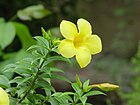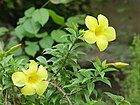Note: This is a project under development. The articles on this wiki are just being initiated and broadly incomplete. You can Help creating new pages.
Allamanda Cathartica
Allamanda cathartica is an evergreen climbing shrub that can reach a free-standing height of 2 metres or produce clambering stems 6 metres or more. Older plants often have multiple stems from the root crown and long stems with relatively few branches. The plant is sometimes used medicinally, even though it is poisonous.
Uses
Parts Used
Chemical Composition
Common names
| Language | Common name |
|---|---|
| Kannada | Arisina hu, Kanagani hu |
| Hindi | |
| Malayalam | |
| Tamil | Manjalpatti |
| Telugu | |
| Marathi | |
| Gujarathi | |
| Punjabi | |
| Kashmiri | |
| Sanskrit | |
| English | Allamanda, Dogben |
Properties
Reference: Dravya - Substance, Rasa - Taste, Guna - Qualities, Veerya - Potency, Vipaka - Post-digesion effect, Karma - Pharmacological activity, Prabhava - Therepeutics.
Dravya
Rasa
Guna
Veerya
Vipaka
Karma
Prabhava
Habit
Identification
Leaf
| Kind | Shape | Feature |
|---|---|---|
Flower
| Type | Size | Color and composition | Stamen | More information |
|---|---|---|---|---|
| Flowering season is January to April |
Fruit
| Type | Size | Mass | Appearance | Seeds | More information |
|---|---|---|---|---|---|
| Fruiting season is August to October |
Other features
List of Ayurvedic medicine in which the herb is used
Where to get the saplings
Mode of Propagation
How to plant/cultivate
A plant of moist, tropical lowland regions, where it can be found at elevations up to 700 metres. It is found growing in Puerto Rico in areas where the mean annual rainfall is in the range 1,000 - 2,800mm, though may be tolerant of a greater range than this. Plants are intolerant of frosts, being killed by temperatures of -1°c[4]
Commonly seen growing in areas
Photo Gallery
References
External Links
- Ayurvedic Herbs known to be helpful to treat Diaphragm
- Herbs with Leaf used in medicine
- Herbs with common name in Kannada
- Herbs with common name in Tamil
- Herbs with common name in English
- Habit - Evergreen Shrub
- Index of Plants which can be propagated by Seed
- Index of Plants which can be propagated by Root Cuttings
- Herbs that are commonly seen in the region of Riverbanks in rain forests
- Herbs that are commonly seen in the region of Invade abandoned farm land
- Herbs that are commonly seen in the region of Waste land
- Ayurvedic Medicine
- Pages without herbs images




